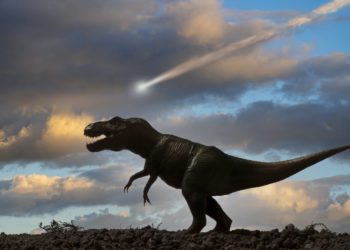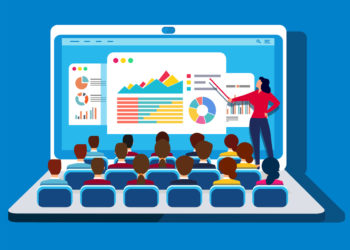This has been a tough couple of years. I for one can say that in my role, leading the publishing division of the American Mathematical Society, I found myself focusing on operations, enabling remote functionality, hunkering down in survival mode, and celebrating the resilience of our staff through a major crisis. In large part, the exhaustive efforts of our team paid off — we are learning to live with the virus and its societal and structural ramifications.
Add to this the longer-term trends of stagnating society membership, a quickening pace towards open research, a fundamental shift away from print to digital content, and a less than clear sense of equity in the publishing ecosystem, we are now looking ahead to a research and teaching landscape that has fundamentally changed. There are key components to consider. How do we operate as a workforce as we move to a new definition of work – a hybrid way of working? How do we hold meetings and conferences inclusively, equitably, and effectively? How may we diversify revenue as membership numbers flatten, or decline, conference revenues are put at risk, and publishing revenues appear to be vulnerable as we move inexorably to open research? How do we best position scholarly society strategies to embrace increasingly interdisciplinary research and education?
In this post, I talk with several forward-thinking Society Executive Directors/CEOs representing a range of fields. I asked them to tackle all, or some of the following topics:
- Remote/hybrid office working, the effects on staff and productivity and culture, consolidation of owned/rented building space.
- Revenue generation: meetings and conferences, publishing – possible strategies for diversification of revenues suitable for your communities.
- Membership and how to attract members under a changing definition of what it means to belong to a scholarly society, including notions of increasing interdisciplinarity – if relevant.
- Response of your society to open access publishing pressures, bearing in mind the many models available, and differences in approach around the world.
I hope you, like me, find their responses to be both fascinating and useful.
In this first post you will hear from Elena Gerstmann (Executive Director of INFORMS), James Grossman (Executive Director of the American Historical Association – AHA), and Catherine Roberts (Executive Director of the American Mathematical Society – AMS).
Part 2 of this post (appearing tomorrow) will include Antonia Seymour (Chief Executive, Institute of Physics Publishing – IOPP), Paula Krebs (Executive Director of the Modern Language Association – MLA), and Tracey DePellegrin (Executive Director of the Genetics Society of America – GSA)

Elena Gerstmann
At INFORMS we are planning for a world where COVID-19 is endemic and there is always a layer of uncertainty. This means we must diversify our offerings and remain flexible. We will use 2022 to streamline our finances and look for efficiencies by evaluating our products and programs to make sure they are still providing value. This will allow us to better allocate our resources – this could mean eliminating some products and investing in others.
Through COVID-19 we have learned that our four walls in Baltimore, MD don’t determine how much work gets done. We have transitioned to a hybrid work environment for our approximately 50 employees. (We have five employees who were full-time remote before the pandemic, and they have remained full-time remote.) We ask our staff to come into the office at least 2 days a week so we can collaborate with one another in-person. So far this seems to have boosted morale and allowed folks to better maintain a life/work balance. I don’t imagine increasing the request from two days/week, but soon we may ask that all employees come in on one common day per month. We will use this day to have enterprise-wide meetings. It’s just about maintaining that team feel and comradery that is so important in the functionality of an organization like INFORMS.
During the pandemic we have seen tremendous growth in our scholarly publications. Our submissions are up more than 25% and our usage is up more than 50%. We have also been able to speed up our time from acceptance to online publication. All our journals already can publish open access, but we continue to monitor the industry to see what else we can do to remain competitive and serve the needs of our research community.
While our membership and conference attendance has taken a hit, especially in 2020, we have seen a rebound in 2021 and expect even more of a rebound in 2022. The pandemic has allowed us to think about our organization and tear down some useless, self-imposed, silos. Now, regardless of what department one may work in or volunteer with, we all try to think, “How can what I’m doing help these other areas?” Some specifics include our publications team doing personal outreach to authors who were not members to ask them to become members, our membership team creating an onboarding online channel for new members to express interest in all the different things we do, etc. In addition to the impact of COVID, the murder of George Floyd shined a light on diversity, equity, and inclusion (DEI). While INFORMS has a long history of successful DEI efforts, we have taken our commitment to DEI to the next level to make sure everything we do is part of the solution. We strive to do better, be better.
COVID has taught us we need to roll with the punches and learn to be flexible and embrace new and different ideas. Things that may have seemed impossible before COVID are not only possible but may be better. New challenges force us to think differently, by thinking differently, only then can we truly break down barriers and reach new heights. At INFORMS, our goal is to constantly elevate. Elevate our members, our profession, our publications and all of our resources to help save lives, save money and solve problems, creating a better future for everyone.
James Grossman
The American Historical Association (AHA) considers the changing landscape of scholarly associations to be filled with new opportunities and we look forward to engaging our members and peer organizations in thinking about both new directions and new ways of thinking about continuing activities.
- The AHA’s experience with remote work, first during our building renovation and then during COVID has helped us learn about new possibilities: both their potential and their limits. It’s clear that our existing remote work policies should be revised, and we will experiment beginning with a 2 day/week minimum office residency. We have learned that staff meetings are most effective when everyone participates in the same format, whether in person or online. We have learned that some elements of our work benefit from in-person interaction; other elements don’t. We will continue to experiment and learn.
- [Editor’s Note: This section is drawn in part from Dr. Grossman’s column in Perspectives on History]. The AHA has been rethinking the focus and culture of its annual meeting over the last five years, and will continue to move in the direction of moving the general character of the conference from what was once considered a “research meeting” to a much broader landscape that emphasizes professional development as an umbrella that encompasses not only research, but teaching, professional practice, advocacy training, and more. We will continue to encourage innovative formats, including those that draw on digital capabilities and that emphasize interaction among participants. We also will begin experimenting with an additional annual event, which will be fully online, separated from the in-person conference by approximately six months. We’ll start by gathering information about what historians would like to see available in an online convening, and then explore logistical feasibility, cost, staff time, and other variables to create new programming that builds on what we have been trying online over the past 18 months. We seek opportunities to increase access to conversation, collaboration, communication, and community. Online programming invites participation from people who cannot travel to our annual meeting for reasons of time, money, physical restrictions, family constraints, and other concerns. We don’t yet know precisely how this will work; we’ve learned that it is neither possible nor desirable to replicate an in-person gathering in an online space. Not only do some things not translate, but there are also opportunities online that are impossible in person. Online gatherings differ from in-person meetings in many ways, including different notions of time, space, communication, and more. We will experiment, beginning modestly and then expanding as we learn. The two gatherings will be different but related events, with different purposes, different application calendars, and different program committees.
- Why should people interested in history and committed to the promotion of historical scholarship and its role in public culture join the AHA? We will continue to ask that question, rather than focus purely on transactional membership benefits. The AHA has been a vocal advocate for the role of history in public culture and the importance of maintaining the professional integrity of history education as well as research. In the current environment this work is essential and we are confident that our colleagues will continue to support our work.
- The AHA is committed to broad public access to the work of historians. We currently have a committee working on broadening definitions of scholarship, in order to make it professionally more feasible for historians to write for broad audiences. Can an op-ed be peer reviewed post hoc? Of course, it can. So can a blog post. Should a textbook or reference book be considered historical scholarship? Our journal’s progressive pricing structure makes it affordable to colleges, universities, and many other institutions that hire historians. It is available on a substantially discounted basis to institutions in parts of the world that lack financial resources for scholarly journals. Historians are committed to open research: we disclose our sources; we advocate for digitization of the primary sources that are essential to the democratization of scholarship and teaching and for free and open access to archives and other repositories. Our most recent statement on “open access” policies is articulated in our response to “Plan S.” We join with our colleagues in other organizations to oppose censorship and other limits on distribution of historical work.
Catherine Roberts
- Prior to the pandemic, I believe that most of my managers would have rejected any proposal to introduce working from home two or more days a week. Yet, we now recognize the benefits of remote work arrangements and understand that it is here to stay. I remain concerned about both productivity and culture, especially as we onboard new staff. There are substantial economic considerations related to this shift in remote work. In addition to determining what remote work support will be offered (e.g., laptops, reimbursement for Wi-Fi, etc.), leaders also face a host of new state regulations with a distributed workforce. Leaders are also reconsidering what sorts of physical building spaces make sense going forward.
- The need to diversify revenue streams is becoming acute. For professional societies such as the AMS, faculty travel support is waning and library budgets are shrinking. We support open access publishing, while also relying on revenue from library subscriptions to support much of our work advocating for and supporting research mathematicians. Meetings and publishing have been significant sources of revenue and as they become challenged, what options do we have? Fortunately, a strong endowment and a history of securing government funding supports my organization. I think our best bets going forward include more development/advancement work as well as more grant seeking. In general, all leaders need to look to innovate new content and services to reduce our reliance on traditional revenue streams.
- Articulating the benefits of membership in one’s professional society can be tricky, when many of the benefits are not easily quantifiable. Sure, AMS membership comes with some perks, such as member publications (but ours are also available for free on the web), as well as discounts on conference registrations and book purchases. Less tangible is the work the AMS undertakes on behalf of the community of researchers to ensure continued federal funding for basic research, to support international cooperation, and to provide resources and products for early-career mathematicians. Professional societies are in it for the long term, and are essential to ensuring the longevity of the research enterprise. This is something that each member of our community must support.
- Open Research, and open access publishing are fundamentally affecting the mathematics community. I want to turn to my colleague, and author of this post, Robert Harington, for a few words on how the AMS is approaching openness in mathematics:
“The AMS supports the drive to open research, including sustainable means for achieving open access to mathematical content. Innovation in this space needs to be tempered with an understanding of the culture of the community you serve – in our case mathematics. As Catherine has discussed, the AMS is not alone in turning over its revenues into projects directly designed to support its research and teaching communities. For us, and I suspect many others, open access models need to be sustainable. Many mathematicians do not receive direct funding for their research. Author-pays Gold open access relies on article processing charges, and for mathematicians this is not a relevant sustainable model. Our approach currently is to develop a broad range of models to suit our community culture. AMS journal content (going back to the beginning of journal publication at the AMS) is freely available online with a five-year moving window. The AMS provides Green OA, subsidized Gold OA (waivers for AMS members), and donor supported Diamond OA, seen in the recent launch of our new flagship journal, Communications of the AMS. It is this balance of options that works for now. There is significant complexity in the market place with a wide range of transformative arrangements that we worry are not as transparent as they should be, and not as equitable as could be. Our priority going forward is to devise new business models that allow for open publishing of books and journals, while sustaining revenues for the Society – easy to say and hard to do – but this is the challenge.”
Join us tomorrow for more responses in Part 2 of this post.


